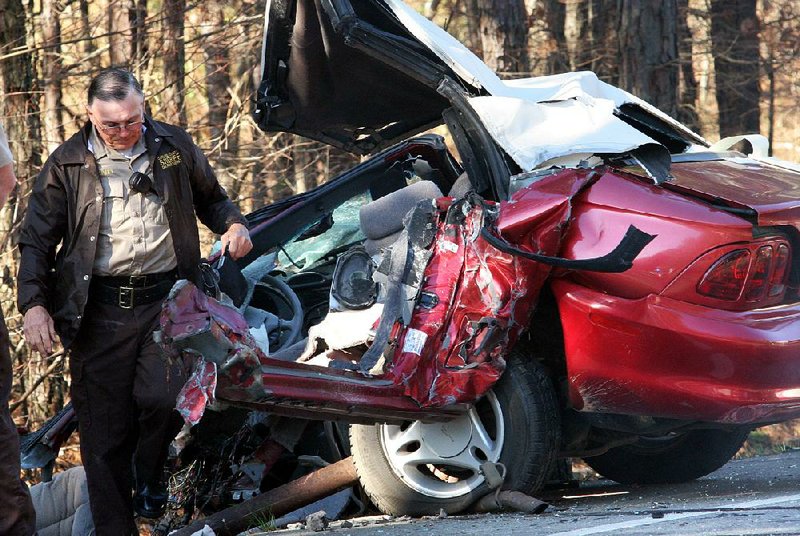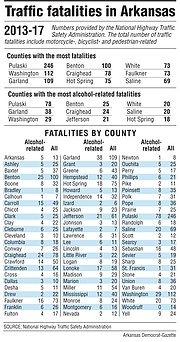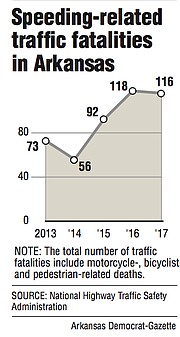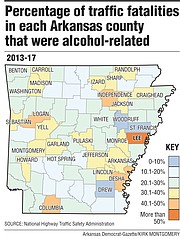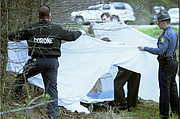HOT SPRINGS -- The 3 a.m. knock at the door echoed throughout Ruth Carney's hotel room.
It was Dec. 4, 2015, and the then-mayor of Hot Springs was attending a convention in Rogers.
"When I opened [the door], City Attorney Brian Albright was standing there," Carney recalled. "He looked at me and said, 'I have some bad news. Your son, Chris, was killed this morning in a car accident.'"
Christopher Carney, 35, had been a passenger in his friend's SUV a few hours earlier, traveling west on U.S. 70 about 6 miles east of Hot Springs in Garland County. Arkansas State Police investigators believe the SUV's driver, Ezekiel Blanton, 37, failed to negotiate a curve about 1:40 a.m. and overcorrected. The vehicle traveled off the road and struck a tree, killing both men.
Carney's son and Blanton were among 12 people who died that year on the well-traveled highway that runs from Interstate 30 south of Benton to Hot Springs and beyond.
"We were dealing with a crisis," Carney said of the number of fatal crashes occurring on U.S. 70.
That stretch of highway and the work that has been done to improve it illustrate a balance that states like Arkansas are trying to attain of not just maintaining roads but also making them safer.
Numbers from the National Highway Traffic Safety Administration's Fatality Analysis Reporting System show that from 2013-17 there were 2,572 traffic fatalities reported in Arkansas. While that was a decrease from the previous five-year total of 2,878, Arkansas still had a higher number of traffic fatalities than states like Nevada, Kansas, Utah and Iowa, which have comparable populations.
Earlier this year, Gov. Asa Hutchinson proposed levying a new wholesale sales tax on gas and diesel fuel, permanently extending the state's half-percent sales tax for highways, and dedicating casino tax revenue and other state funds to raise $300 million annually for the Arkansas Department of Transportation.
The plan is the single-largest highway plan in the state's history. If passed by voters in 2020, the Arkansas Department of Transportation will determine the best way to use the additional funding beginning in 2024. Part of that plan will include adding safety measures to a rural highway system that's filled with roads that are often narrow and winding, while also maintaining the state's scenic reputation.
Fatalities by county 2013-2017 | Fatalities per 100,000 people, 2017 | Alcohol fatalities, 2013-2017 | Speeding fatalities, 2013-2017 | Fatalities involving large trucks, 2013-2017 | Five-year trend for top 10 counties
"When you improve roads, you improve safety," said J.R. Davis, Hutchinson's spokesman. "Adding lanes, shoulders and barricades are all safety measures."
THE NUMBERS
Arkansas averaged 514 fatal highway crashes per year from 2013-17, according to Fatality Analysis Reporting System data, with a five-year high of 504 crashes and 561 deaths in 2016. That works out to about 19 deaths per 100,000 people.
The top five counties in fatal crashes over the 2013-17 period were Pulaski, Washington, Garland, Benton and Craighead, according to Fatality Analysis Reporting System data.
Pulaski County averaged 49 fatal crashes annually during the span, while Washington and Garland counties were second with an average of 22 a year.
It's no surprise that Pulaski and Washington counties were among the leaders in fatal crashes. Pulaski County is home to Little Rock, the largest city in the state with a population of 197,780, according to U.S. Census data. Washington County is home to Fayetteville, the state's third-largest city with 81,889 people, and the University of Arkansas, Fayetteville. Both counties deal with a high number of drivers on the road.
The outlier was Garland County, the state's eighth-most-populated county, which had 109 fatal crashes during the 2013-17 period, the third-highest number of such crashes in the state.
Tourism played a substantial role in that. While Hot Springs' 36,780 population is substantially smaller than Little Rock's or Fayetteville's, the city draws visitors from across the region and even the nation. It is the home of Oaklawn Racing Casino Resort, Hot Springs National Park, the world-famous Bathhouse Row, and Magic Springs Theme and Water Park.
The influx of tourists means more drivers traveling U.S. 70.
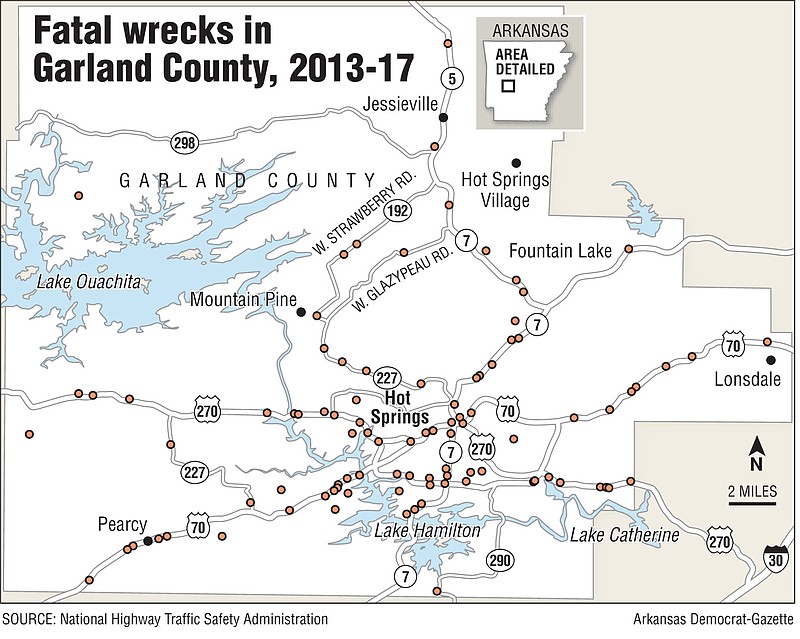
The fatal crash numbers resonate with Carney, who led an effort for additional safety measures to be made on U.S. 70.
"The fatal accidents I read about become personal," she said. "I kind of go there in my mind, and I kind of identify in my mind with whoever is having their door knocked on early in the morning. It's personal."
A DANGEROUS ROAD
Often it's difficult to pinpoint the cause of a fatal crash, officials said.
"Each accident has its own uniqueness," said Bill Sadler, a spokesman for the Arkansas State Police. "We don't assume because two accidents might happen in the same area in one week that they are related. One could be because of drowsiness or the weather, and the other could be an equipment malfunction."
More than one factor is usually at work in fatal crashes, said Russ Rader, senior vice president for communications at the Insurance Institute for Highway Safety's Highway Loss Data Institute. The Insurance Institute for Highway Safety is a nonprofit organization dedicated to reducing the losses associated with motor vehicle crashes.
"Leading factors are speed, alcohol impairment and lack of attention," Rader said, noting that safety advocates prefer to use the term "crashes" instead of "accidents" because all crashes are preventable, rather than accidents that can't be helped.
Garland County officials pointed to U.S. 70 as a primary factor in the county's high number of fatal wrecks.
"There was a lot of accidents on the curves and the straightaways," Garland County Sheriff Michael McCormick said. "There was an unprecedented amount of fatalities on that road."
County Judge Darryl Mahoney agreed.
"The areas are scenic for a reason," he said. "The terrain wasn't meant for high speeds. The roads were kind of narrow and curvy. They weren't banked correctly, and there was high shoulders."
Rader said his group uses fatal crash data to identify strategies that can reduce the number of crashes.
"You'll see that rural states stand out with higher fatality rates because they have a larger share of dangerous, rural, two-lane highways," he said. "Fatal crashes are more likely on higher-speed rural roads, as opposed to congested, lower-speed urban streets."
In 2015, the Arkansas Department of Transportation acknowledged it was time to make changes to U.S. 70.
"We had discussed this area over and over, and then when they finally decided they would do something about this, we begged them, literally, please start on [the Garland County] end," Carney said. "They said, no, we are going to start on [the Saline County] end, which was the Benton and Bryant end.
"That kind of upset us, because we talked to them quite a bit about that crisis on this end of it."
ADDITIONAL FACTORS
Other factors also played into Garland County's high number of fatal crashes, officials said.
Speed was among them, according to Danny Straessle, a spokesman at the Arkansas Department of Transportation.
Of the 2,572 fatal crashes reported statewide by the Fatality Analysis Reporting System, speeding was listed as a cause in 455 of them. Incidents where speeding was listed among the causes increased from 2013-16, followed by a small drop in 2017. Data show that 234 of the 455 fatal crashes occurred from 2016-17.
A 2015 study showed that the speed limit on U.S. 70 was 55 mph, but traffic was traveling at 70 mph, according to the Department of Transportation.
Pat McCabe, the current mayor of Hot Springs, said speeding was especially noticeable after events at Oaklawn.
"Everyone was leaving the track like they were race car drivers," McCabe said. "They were all juiced up from the races, and they headed back home in a hurry."
Mahoney, the county judge, said another contributing factor is that a large portion of the county's population lives outside of Hot Springs.
"We have a large segment of our population living in areas with higher speed limits than in the metro areas," Mahoney said. "This means we have higher speeds in densely populated areas. For example, you got Lake Hamilton, which is densely populated and has speeds of 50 mph and 60 mph."
Fatality Analysis Reporting System data show that Hot Springs averaged five fatal crashes a year from 2013-17, which was higher than in such cities as Pine Bluff, Benton, Bentonville, Conway and Rogers
"We have much more traffic on our streets than [other cities] our size because of the tourism," McCabe said. "We have over 3 million visitors come to Hot Springs a year."
Alcohol also played a substantial role in fatal crashes. Thirty-eight of Garland County's 109 fatal accidents from 2013-17 involved an alcohol-impaired driver, according to Fatality Analysis Reporting System data.
That was less than Pulaski County, which led the state with 78 alcohol-related fatal wrecks over the same span, but higher than Washington County (29) and Benton County (25).
Hot Springs Police Chief Jason Stachey said he conducted his own five-year study over the same period and found 32 reported fatal crashes inside the city, 12 of which involved impaired driving.
Carney wasn't surprised.
"It concerns me that our area, our community, focuses on alcohol," she said. "Another bar, another brewery, another beer festival, and nobody knows how it affects our community."
THE FIX
Efforts have been made over the past five years to address the problems that have contributed to Garland County's fatal crashes.
Roads have been changed, and law enforcement agencies have adjusted their policies.
In June of 2018, the state Department of Transportation completed a project to widen U.S. 70 in Garland and Saline counties.
The project, which cost about $78.5 million, included expanding the highway to five lanes; making safety improvements that included straightening curves, flattening ditch slopes, eliminating limited-length passing lanes and providing a continuous center turn lane; and installing a traffic signal where U.S. 70 intersects with Arkansas 128.
Stachey said law enforcement agencies also began cracking down on impaired driving after receiving a grant that allowed agencies to pay officers extra for overtime.
There were 13 fatal crashes in Garland County in 2017, a 58 percent decline from the previous year's 31, according to Fatality Analysis Reporting System data. In 2018, there were 17 fatal crash reports, according to unofficial data from the Arkansas State Police.
Traffic in Garland County is expected to increase in the coming years as Oaklawn moves forward with its planned expansion and casino addition, but McCormick said the county will be ready.
"Whatever it takes, we are going to keep the roads of Garland County safe," the sheriff said.
Rader said data show that high-visibility enforcement of speed limits, impaired driving laws and seatbelt laws have significant effects in reducing fatal crashes.
Garland County enforcement officials agreed, but said consistent road improvements will be needed as well.
"Road safety is everyone's responsibility -- the vehicle manufacturer, the road department, law enforcement, the driver behind the wheel," Straessle said. "More often than not, it's the driver."
Even with the changes that have been made to U.S. 70 and the increased efforts to raise awareness of road safety, Carney will never be able to forget the highway's reputation for danger.
Or that knock on the door in 2015.
"The curve is still there in essence," she said. "They straightened it out a little bit, but every time I drive on that road I see the tree. I never miss it.
"Every time I go by it's like, 'that is where it happened. Right there.'"
SundayMonday on 05/05/2019
